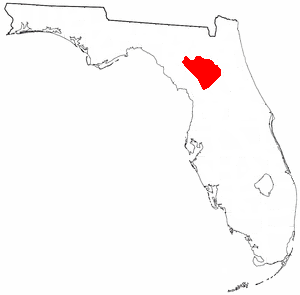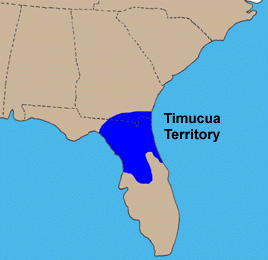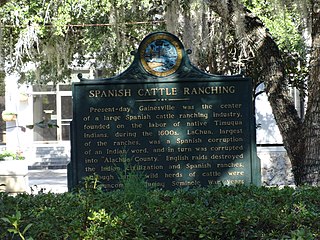Related Research Articles

The Potano tribe lived in north-central Florida at the time of first European contact. Their territory included what is now Alachua County, the northern half of Marion County and the western part of Putnam County. This territory corresponds to that of the Alachua culture, which lasted from about 700 until 1700. The Potano were among the many tribes of the Timucua people, and spoke a dialect of the Timucua language.

Beginning in the second half of the 16th century, the Kingdom of Spain established a number of missions throughout La Florida in order to convert the Native Americans to Christianity, to facilitate control of the area, and to prevent its colonization by other countries, in particular, England and France. Spanish Florida originally included much of what is now the Southeastern United States, although Spain never exercised long-term effective control over more than the northern part of what is now the State of Florida from present-day St. Augustine to the area around Tallahassee, southeastern Georgia, and some coastal settlements, such as Pensacola, Florida. A few short-lived missions were established in other locations, including Mission Santa Elena in present-day South Carolina, around the Florida peninsula, and in the interior of Georgia and Alabama.
The Surruque people lived along the middle Atlantic coast of Florida during the 16th and 17th centuries. They may have spoken a dialect of the Timucua language, but were allied with the Ais. The Surruque became clients of the Spanish government in St. Augustine, but were not successfully brought into the Spanish mission system.

The Timucua were a Native American people who lived in Northeast and North Central Florida and southeast Georgia. They were the largest indigenous group in that area and consisted of about 35 chiefdoms, many leading thousands of people. The various groups of Timucua spoke several dialects of the Timucua language. At the time of European contact, Timucuan speakers occupied about 19,200 square miles (50,000 km2) in the present-day states of Florida and Georgia, with an estimated population of 200,000. Milanich notes that the population density calculated from those figures, 10.4 per square mile (4.0/km2) is close to the population densities calculated by other authors for the Bahamas and for Hispaniola at the time of first European contact. The territory occupied by Timucua speakers stretched from the Altamaha River and Cumberland Island in present-day Georgia as far south as Lake George in central Florida, and from the Atlantic Ocean west to the Aucilla River in the Florida Panhandle, though it reached the Gulf of Mexico at no more than a couple of points.
Mission San Francisco de Potano was a Spanish mission near Gainesville, Florida, United States. The mission of San Francisco de Potano was founded in 1606 by the Franciscans Father Martín Prieto and Father Alonso Serrano. It was the first doctrina in Florida west of the St. Johns River. The mission was at the south edge of present-day San Felasco Hammock Preserve State Park.

The Agua Dulce or Agua Fresca (Freshwater) were a Timucua people of northeastern Florida. They lived in the St. Johns River watershed north of Lake George, and spoke a dialect of the Timucua language also known as Agua Dulce.

The Northern Utina, also known as the Timucua or simply Utina, were a Timucua people of northern Florida. They lived north of the Santa Fe River and east of the Suwannee River, and spoke a dialect of the Timucua language known as "Timucua proper". They appear to have been closely associated with the Yustaga people, who lived on the other side of the Suwannee. The Northern Utina represented one of the most powerful tribal units in the region in the 16th and 17th centuries, and may have been organized as a loose chiefdom or confederation of smaller chiefdoms. The Fig Springs archaeological site may be the remains of their principal village, Ayacuto, and the later Spanish mission of San Martín de Timucua.
Nicolás Suárez Ponce de León was the accountant for the Royal Treasury of Spanish Florida from 1630 until his death in 1651, and from 1631 to 1633 served as acting co-governor of the colony with Eugenio de Espinosa, when Governor Andres Rodriguez Villegas died in office, and also for a few months in 1651.
The Yustaga were a Timucua people of what is now northwestern Florida during the 16th and 17th centuries. The westernmost Timucua group, they lived between the Aucilla and Suwannee Rivers in the Florida Panhandle, just east of the Apalachee people. A dominant force in regional tribal politics, they may have been organized as a loose regional chiefdom consisting of up to eight smaller local chiefdoms.
Benito Ruíz de Salazar Vallecilla was twice governor of Spanish Florida, from 1645 to 1646 and from 1648 to 1651.
Pedro Menéndez Márquez was a Spanish military officer, conquistador, and governor of Spanish Florida. He was a nephew of Pedro Menéndez de Avilés, who had been appointed adelantado of La Florida by King Philip II. Márquez was also related to Diego de Velasco, Hernando de Miranda, Gutierre de Miranda, Juan Menéndez Márquez, and Francisco Menéndez Márquez, all of whom served as governors of La Florida.
Pedro Benedit Horruytiner y Catalán was a Spanish soldier who served as interim co-governor of Spanish Florida between 1646 and 1648, and as governor between 1651 and 1654. When governor Benito Ruíz de Salazar Vallecilla was suspended from office in 1646, acting royal contador Horruytiner and Francisco Menendez Marquez served as co-governors until Salazar Vallecilla was returned to office in 1648.
Ocale was the name of a town in Florida visited by the Hernando de Soto expedition, and of a putative chiefdom of the Timucua people. The town was probably close to the Withlacoochee River at the time of de Soto's visit, and may have later been moved to the Oklawaha River.
San Buenaventura de Potano was a Spanish mission near Orange Lake in southern Alachua County or northern Marion County, Florida, located on the site where the town of Potano had been located when it was visited by Hernando de Soto in 1539. The Richardson/UF Village Site (8AL100), in southern Alachua County, has been proposed as the location of the town and mission.
Tomás Menéndez Márquez y Pedroso (1643–1706) was an official in the government of Spanish Florida, and owner, with his brothers, of the largest ranch in Spanish Florida. He was captured by pirates in 1682 and held for ransom, but was rescued by the Timucua.
Francisco Menéndez Márquez y Posada was a royal treasurer and interim co-governor of Spanish Florida, and the founder of a cattle ranching enterprise that became the largest in Florida.
Juan Menéndez Márquez y Valdés (1531–1627) was royal treasurer and interim governor of Spanish Florida, and governor of Popayán Province. He was the father of Francisco Menéndez Márquez, who succeeded him as governor of Florida (1646–1648).
Arapaha was a Timucua town on the Alapaha River in the 17th century. The name was also sometimes used to designate a province or sub-province in Spanish Florida.
Bartolomé de Argüelles was the lieutenant treasurer, royal accountant and co-interim governor of La Florida (1595–1597) with Alonso de las Alas and Juan Menéndez Márquez. He served as lieutenant treasurer during the administration of governor Pedro Menéndez de Márquez (1577-1594).

Cattle ranching was an important industry in Spanish Florida in the second half of the seventeenth century. The Spanish were in Florida for almost a century before ranching became widespread in the colony. Late in the seventeenth century, ranches were located along the middle St. Johns River, in Potano Province, and in Apalachee Province. Ranches flourished despite conflicts with the native people of Florida. Attacks by the English colony, the Province of Carolina, and its native allies brought an abrupt end to ranching in Florida at the beginning of the eighteenth century.
References
- ↑ Bushnell (1978), p. 412.
- ↑ Bushnell (1981), p. 18, 145–146.
- ↑ Bushnell (1981), pp. 1–2.
- ↑ Chipman (2005).
- ↑ Parry (1966), pp. 202–203.
- ↑ Bushnell (1978), p. 418.
- ↑ Worth, John E. "The Governors of Colonial Spanish Florida, 1565-1763". University of West Florida. Archived from the original on 17 October 2013. Retrieved 13 October 2013.
- 1 2 Bushnell (1981), pp. 129, 146–147.
- ↑ Bushnell (1978), p. 410.
- ↑ Blanton (2014), pp. 682–683.
- ↑ Bushnell (1978), pp. 124, 414, 418–419.
- ↑ Bushnell (1981), p. 133.
- ↑ Simpson, J. Clarence (1956). Florida Place-Names of Indian Derivation. Tallahassee, Florida: Florida Geological Survey. pp. 20–21.
- ↑ Baker (1993), pp. 97–98.
- ↑ Bushnell (1978), p. 408.
- ↑ Bushnell (1978), pp. 422–424.
- ↑ Bushnell (1991), pp. 128–130, 134.
- ↑ Hann (1996), p. 193.
- ↑ Arnade (1961), p. 122.
- ↑ Blanton (2014), p. 672.
- ↑ Bushnell (1978), pp. 426, 428–429, 430.
- ↑ Milanich (1996), p. 113.
- ↑ Hann (1996), p. 211.
- ↑ Worth (1998a), p. 201.
- ↑ Borgen (2011), pp. 16, 26, 40, 64, 101.
- ↑ Hann (1996), pp. 210–211.
- ↑ Worth (1998a), pp. 200–201.
- ↑ Bushnell (1978), pp. 428–429.
- ↑ Bushnell (1991), pp. 130, 134.
- ↑ Hann (1996), p. 194.
- ↑ Worth (1998b), p. 131.
- ↑ Bushnell (1978), pp. 421, 426, 429, 430.